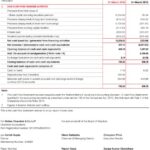Content
Non-cash expenses are the amounts paid for items that do not require money to be taken out of the business. Examples include Depreciation, depletion, amortization, and certain other non-cash expenses such as loss on disposal of Fixed Assets (which is actually additional Depreciation). Noncash expenses are types of business expenses that are not paid in cash and are non-tangible that can include depreciation, amortization, bad debts, advertising costs, and research and development.

All such information is provided solely for convenience purposes only and all users thereof should be guided accordingly. The practice is to show the actual amount of cash received on the sale of a fixed asset as a source of cash. Use an amortization calculator to determine what your future loan repayments are going to be.
How confident are you in your long term financial plan?
This is why businesses need to be careful while accounting for non-cash items. The $1,000 noncash expense shows up on our income statement as depreciation. For example, a loss on the disposal of an asset that occurred this year is included in the current Cash Flow statement. As such, the loss is added back to the amount of net profit (as disclosed by the income statement) to arrive at the correct cash flow generated by operational activities.
- In comparison, a lower estimate can create a problem in the future for meeting future obligations in the case where actual expenditure exceeds planned.
- If a company’s profit did not fully reflect the cash outlay for the asset at that time, it must be reflected over a set number of subsequent periods.
- Use an amortization calculator to determine what your future loan repayments are going to be.
- Non-cash items that are reported on an income statement will cause differences between the income statement and cash flow statement.
- The most common example of a non-cash expense is depreciation – where the cost of an asset is spread out over time even though the cash expense occurred all at once.
- These expenses may have been incurred in previous accounting periods or are expected to be incurred in the future.
There are always two sides to every situation- one being a positive one and another being the negative one. The market price of an investment as on the balance sheet may be different date from its initial purchase price. If the market price on the balance sheet date is higher than its purchase price, it’s a situation of unrealized gain.
Why is depreciation and amortization expense considered a non-cash expense?
Since the invoice for the expenses incurred is received in Year 1, expenses of $100,000 will be recorded in Year 1, thereby netting a surplus of $25,000 in Year 1. Not all noncash charges will reduce cash and cash equivalents on the cash flow statement. Depreciation, for example, impacts earnings but does not have a direct impact on cash flows. Amortization is the process used to determine the annual costs for intangible assets and reduce them from balance sheet account balances to reflect a pattern of using them up equally during each year’s period. When the amount of depreciation is debited in the income statement, the amount of net profit is lowered yet there is no cash flow. This particular entry is one that some users misinterpret based on their own understanding of what a non-cash expense might be.

Management should analyze and accurately record such non-cash expenses as there exists room for window dressing by under/ over-stating such expenses in the company’s Income Statement. It is a method of writing off the cost of a physical or tangible asset over its useful life and represents how much an asset has been used till now. Charging depreciation helps businesses to charge off the cost of a relevant asset according to its usage.
A quick guide to noncash expenses
In accounting terms, items such as depreciation and amortization are included in the net income of a business. However, these transactions do not impact the cash flow of the business but have a significant impact on the bottom line of the income statements, i.e.reduces, the profits reported. Non-cash expenses are the same as other https://kelleysbookkeeping.com/ write-downs, which results in the lowering of reported earnings. Non-cash items that are reported on an income statement will cause differences between the income statement and cash flow statement. Common non-cash items are related to the investing and financing of assets and liabilities, and depreciation and amortization.

Maria ends up purchasing several copyrights for $10,000 and will be good for the next ten years. Finance Strategists is a leading financial education organization that connects people with financial professionals, priding itself on providing accurate and reliable financial information to millions of readers each year. The articles and research support materials available on this site are educational and are not intended to be investment or tax advice.
While that is true if you’re using cash basis accounting, if you’re using accrual accounting, a recorded expense does not always include a reduction of cash. Cash expenses are those that require an outflow of cash from the business in order for them to be incurred. Examples of cash expenses include salaries, interest on loans, and taxes.Non-cash expenses are those that do not require an outflow of money in order to be incurred.
- The business charges depreciation on long-term assets for both tax and accounting purposes.
- Management should analyze and accurately record such non-cash expenses as there exists room for window dressing by under/ over-stating such expenses in the company’s Income Statement.
- It is also a good way to accurately assess true business performance as it excludes nonrecurring events such as one-time sales or loan repayments.
The most common example of a non-cash expense is depreciation, where the cost of an asset is spread out over time even though the cash expense occurred all at once. Amortization is similar to depreciation but deals with intangible assets such as patents, copyrights, and other assets that do not have a physical presence but need to be expensed over their useful life. And like a depreciation expense, an amortization expense is considered a non-cash expense, since the asset has already been paid for.
Dive in for free with a 10-day trial of the O’Reilly learning platform—then explore all the other resources our members count on to build skills and solve problems every day. Take O’Reilly with you and learn anywhere, anytime on your phone and tablet. Mary Girsch-Bock is the expert on accounting software and payroll software for The Ascent. Someone on our team noncash expenses will connect you with a financial professional in our network holding the correct designation and expertise. Ask a question about your financial situation providing as much detail as possible. Our mission is to empower readers with the most factual and reliable financial information possible to help them make informed decisions for their individual needs.
- Our experts love this top pick, which features a 0% intro APR for 15 months, an insane cash back rate of up to 5%, and all somehow for no annual fee.
- To know the true cost of running a program, a portion of the indirect costs such as salaries of support staff such as finance, HR, etc. need to be allocated to these programs as well.
- While that is true if you’re using cash basis accounting, if you’re using accrual accounting, a recorded expense does not always include a reduction of cash.
- The noncash items are subtracted from the income statement to prepare the cash flow statement.
- Also, although noncash expenses do not cost a business any money, they still have a monetary value and are therefore very important and should be accurately accounted for.
- Ask questions and participate in discussions as our trainers teach you how to read and understand your financial statements and financial position.
Organizations often seek to play down the importance of non-cash expenses significantly one after another to adjust earnings to evacuate the impact on financial figures. In accounting, noncash items are financial items such as depreciation and amortization that are included in the business’ net income, but which do not affect the cash flow. While they may not impact the net cash flow of the business, these expenses impact the bottom-line of the income statement and result in lower reported earnings.
